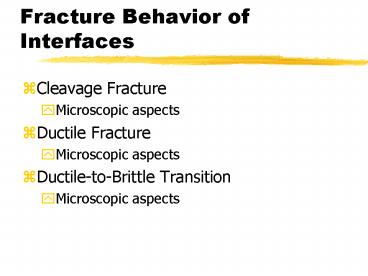Fracture Behavior of Interfaces - PowerPoint PPT Presentation
1 / 13
Title:
Fracture Behavior of Interfaces
Description:
Tongues form when the cleavage crack meets a site of deformation twinning. The cleavage crack continues to form on the interface of the twin boundary, ... – PowerPoint PPT presentation
Number of Views:44
Avg rating:3.0/5.0
Title: Fracture Behavior of Interfaces
1
Fracture Behavior of Interfaces
- Cleavage Fracture
- Microscopic aspects
- Ductile Fracture
- Microscopic aspects
- Ductile-to-Brittle Transition
- Microscopic aspects
2
Microscopic Aspects of Cleavage Fracture
- Cleavage fracture occurs by separation along
crystallographic planes of a material - When fracture travels through grains, it must
change direction with respect to the normal
fracture direction - Features of cleavage fracture include
- Ledges or steps
- Cleavage tongues and river patterns
3
Microscopic Aspects of Cleavage Fracture
- Figure 8.13 pg 234 of Nonlinear Fracture
Mechanics for Engineers
4
Microscopic Aspects of Cleavage Fracture
- Figure 8.14a and b
- with descriptions
5
Microscopic Aspects of Cleavage Fracture
- River patterns are caused by the merging of
several cleavage steps in the vicinity of grain
boundaries - The cleavage steps give the appearance of a river
pattern from which the crack direction may be
seen - Tongues form when the cleavage crack meets a site
of deformation twinning - The cleavage crack continues to form on the
interface of the twin boundary, eventually
sticking out like a tongue
6
Microscopic Aspects of Cleavage Fracture
- When a polycrystalline sample is deformed, the
deformed grains are constrained by the
surrounding grains - This is necessary to maintain continuity of the
material - If the grains are not constrained and allowed to
deform as single crystals, gaps form and grains
overlap - This occurs due to the fact that the slip planes
in each of the grains is oriented differently
form one another and react differently to the
applied strain
7
Microscopic Aspects of Cleavage Fracture
- Figure 8.16 pg 238 in Nonlinear Fracture
Mechanics for Engineers
8
Microscopic Aspects of Cleavage Fracture
- Cleavage fracture occurs due to a lack of
available slip systems - Each grain requires a minimum of five slip
systems to accommodate a state of strain - When these are not available, stresses occur,
especially on grain boundaries, giving rise to
cleavage fracture - FCC materials, containing 12 slip systems, do not
exhibit cleavage fracture
9
Microscopic Aspects of Ductile Fracture
- The classic example of ductile fracture
- FCC pure metals in tensile testing experience
severe necking - Avoid cleavage fracture due to their 12 slip
system - Figure 8.22 pg 247 Nonlinear Fracture Mechanics
for Engineers
10
Microscopic Aspects of Ductile Fracture
- Engineering alloys contain particles which alter
ductile fracture behavior - Some of these are added deliberately to
strengthen the material - These particles create voids in the material
which eventually grow large enough for failure to
occur - By contrast, in cleavage fracture, these
particles become sites where microcracks form and
eventually grow large enough to cause failure
11
Microscopic Aspects of Ductile Fracture
- Figure 8.23 pg 248 Nonlinear Fracture Mechanics
for Engineers
12
Ductile to Brittle Transition Microscopic Aspects
- Occurs as a competition between ductile tearing
and cleavage fracture - Ductile crack growth occurs via void growth
- Cleavage fracture by a stress controlled process
- The method of fracture depends upon the size and
geometry of the specimen - Either may occur at a fixed temperature as seen
in the figure on the next page - Cleavage fracture usually occurs at a higher
constraint than ductile fracture
13
Ductile to Brittle Transition Microscopic Aspects
- Figure 8.30 pg 258 Nonlinear Fracture Mechanics
for Engineers































